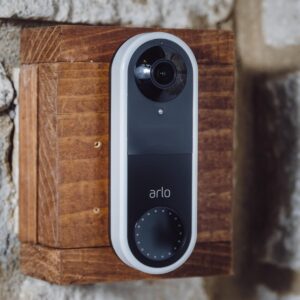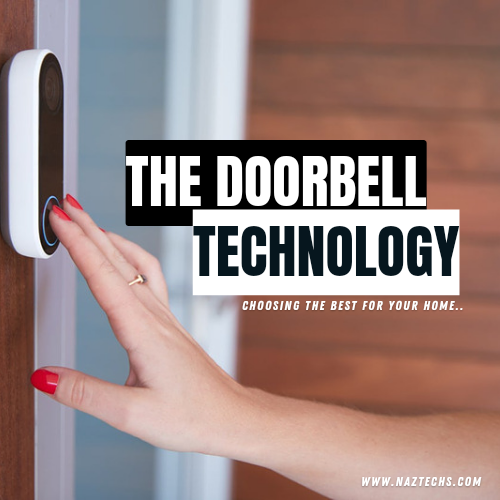The doorbell, often overlooked in the grand scheme of home technology, plays a vital role in enhancing security and convenience for homeowners.
With advancements in smart home technology, doorbells have evolved beyond their traditional form, offering a plethora of features and designs to choose from.
Traditional Wired Doorbells

Wired doorbells have been a staple in homes for decades, known for their reliability and simplicity. They consist of a push button outside the door and a chime box inside the house, connected by electrical wiring.
One of the main advantages of traditional wired doorbells is their consistent performance, as they don’t rely on wireless signals. However, installation can be more complex, often requiring professional assistance due to the electrical work involved.
Wired Doorbells Designs
The history of traditional wired doorbell designs dates back to the late 19th century when technological advancements began to revolutionize the way people communicated and interacted with their surroundings.
The invention of the wired doorbell marked a significant step in making homes more connected and convenient.
Early Beginnings
Before the invention of the wired doorbell, homes relied on more primitive methods to announce visitors, such as door knockers or manual bells. These methods, while functional, lacked the convenience and efficiency that a wired doorbell would later bring.
The First Electric Doorbell
The concept of an electric doorbell was introduced in the early 1800s by inventors who were experimenting with electrical circuits. However, it wasn’t until the mid-1800s that the first practical electric doorbell was patented.
Innovators like Joseph Henry and Alexander Graham Bell contributed to the development of early electric signaling devices, which laid the groundwork for the wired doorbell’s invention.
Early Mechanisms
The earliest wired doorbells used simple mechanisms. When a visitor pressed the button outside the door, it completed an electrical circuit, sending a signal to the chime inside the house.
The chime, often a set of tuned bells or metal bars, would then ring, indicating the arrival of a guest. These mechanisms were often cumbersome and required manual adjustment to achieve the desired chime sound.
Advancements and Standardization
As technology advanced, doorbell designs became more refined. Innovations in electromagnetic technology allowed for more reliable and adjustable mechanisms.
By the late 1800s, doorbell manufacturers began producing standardized systems that were easier to install and maintain.
The wiring systems became more organized and aesthetically pleasing, leading to the classic design that is still recognizable today.
Integration with Homes
By the early 20th century, wired doorbells had become a common fixture in many homes. As urbanization increased and more people lived in multi-story buildings, wired doorbells became essential for efficient communication between residents and visitors.
The chime boxes were often located in central areas of the home, making it easy for everyone to hear when someone was at the door.
Durability and Reliability
One of the key factors that contributed to the enduring popularity of wired doorbells was their durability and reliability.
Unlike some of the wireless technologies of the time, wired doorbells did not suffer from interference or signal disruptions.
This made them a dependable choice for homeowners seeking a consistent method of announcing visitors.
Modern Innovations
While the fundamental concept of wired doorbells remains the same, modern innovations have led to improvements in both functionality and design.
Today, wired doorbells come in a variety of styles and chime sounds, catering to diverse tastes and preferences.
The wiring systems have also become more streamlined, making installation and maintenance more accessible to homeowners.
Why Will We Recommend Wired Doorbells?
1. Reliable: Wired doorbells don’t rely on batteries or wireless connections, ensuring consistent performance.
2. Minimal Maintenance: With no batteries to replace, these doorbells require less maintenance over time.
3. Cost-Effective: Wired doorbells are generally more affordable upfront compared to some wireless alternatives.
Why Won’t We Recommend Wired Doorbells?
1. Complex Installation: Installation may involve drilling holes and working with electrical wiring, necessitating professional help.
2. Limited Placement: The need for wiring limits the flexibility of doorbell placement.
Wireless Doorbells

Wireless doorbells have gained popularity due to their ease of installation and flexibility. They consist of a wireless button and a receiver chime that can be plugged into any standard electrical outlet. Wireless doorbells are available in a wide range of designs and offer various features.
Wireless Doorbell Designs
Wireless doorbells are a technological innovation that reflects the growing need for convenience and flexibility in modern living. The doorbells, which eliminate the need for complicated wiring systems, have transformed the way people interact with their homes and visitors.
Early Experiments with Wireless Communication
The concept of wireless communication dates back to the 19th century, with inventors like Nikola Tesla and Guglielmo Marconi making significant contributions.
The development of radio technology paved the way for wireless communication systems, including doorbells.
Emergence of Radio Signals
In the early 20th century, radio signals became a viable means of transmitting information wirelessly.
This technology set the stage for wireless doorbells, as inventors began to explore ways to apply this new communication method to everyday devices.
The Birth of Wireless Doorbells
The first wireless doorbells began to emerge in the mid-20th century. These early models used radio frequency signals to transmit the doorbell’s push-button signal to a receiver inside the house.
This eliminated the need for complex wiring and made installation significantly easier. However, these early wireless doorbells were often limited in range and susceptible to interference from other electronic devices.
Advancements in Wireless Technology
As electronics technology advanced, so did wireless doorbells. The introduction of more advanced radio frequency technology and the development of dedicated frequency bands helped improve the reliability and range of wireless signals.
By the late 20th century, wireless doorbells were becoming more mainstream, offering homeowners a convenient and flexible alternative to traditional wired systems.
Incorporating Battery-Powered Buttons
A significant advancement in wireless doorbell technology came with the integration of battery-powered push buttons. These buttons eliminated the need for a wired connection between the button and the receiver.
This breakthrough not only made installation even simpler but also allowed for more creative placement of the doorbell button.
Modern Wireless Doorbells
Today’s wireless doorbells come equipped with a range of features that cater to diverse homeowner preferences. Many models offer a variety of chime sounds, adjustable volume settings, and even visual indicators for the hearing impaired.
Some wireless doorbells also incorporate video functionality, allowing homeowners to see and communicate with visitors remotely through integrated cameras and mobile apps.
Integration with Smart Home Technology
The rise of smart home technology has further transformed wireless doorbells. Smart doorbells, often referred to as video doorbells, combine wireless functionality with advanced features like two-way communication, motion detection, and integration with smartphones and other smart devices.
This evolution has elevated the role of the doorbell from a simple notification device to a comprehensive home security and communication tool.
Why Will We Recommend Wireless Doorbells?
1. Easy Installation: Wireless doorbells can be installed without any wiring, making them a suitable DIY option.
2. Flexible Placement: Since they are not tied to wiring, you can place the receiver chime anywhere within the wireless range.
3. Customization: Many wireless doorbells offer a variety of chime sounds and volume settings.
Why Won’t We Recommend Wireless Doorbells?
1. Battery Maintenance: The wireless button often relies on batteries, which need periodic replacement.
2. Signal Interference: Wireless doorbells can be susceptible to interference from other electronic devices.
3. Signal Range: The range between the button and receiver may be limited, affecting performance in larger homes.
Smart Doorbells

The rise of smart home technology has given birth to a new breed of doorbells known as smart doorbells or video doorbells. These devices combine the functionality of a doorbell with advanced features like video surveillance, two-way communication, and integration with smartphones.
Smart Doorbell Designs
The history of smart doorbells is a testament to the rapid evolution of technology and the integration of innovative features into everyday household items.
Smart doorbells, also known as video doorbells, have redefined home security and convenience by combining traditional doorbell functionality with advanced surveillance and communication capabilities.
Early Beginnings of Smart Home Technology
The concept of smart home technology began to gain traction in the late 20th century, driven by the increasing availability of affordable microprocessors and the internet.
As homes became more connected, inventors and engineers sought to create devices that could enhance security, convenience, and energy efficiency.
Birth of Video Surveillance
The development of compact and affordable cameras in the 21st century played a crucial role in the evolution of smart doorbells.
These cameras allowed homeowners to monitor their properties remotely, giving rise to the idea of integrating cameras with doorbell systems to provide a comprehensive view of visitors and surroundings.
Introduction of Smart Doorbells
The first true smart doorbell, the “SkyBell,” was introduced in 2013. It combined a video camera, two-way audio communication, and remote monitoring capabilities into a single device.
This marked a significant shift in the way people interacted with their front doors and set the stage for the development of more advanced smart doorbell models.
Rise of Wireless Connectivity and Mobile Apps
The widespread adoption of smartphones and the proliferation of high-speed wireless internet connections paved the way for the rapid expansion of smart doorbell technology.
With mobile apps, homeowners could receive notifications and access live video feeds from their smart doorbells, even when they were away from home.
Integration with Home Security Systems
As the smart home ecosystem grew, smart doorbells began to integrate with other home security devices, such as motion sensors, door locks, and security cameras.
This integration allowed homeowners to create comprehensive security solutions that could be controlled and monitored from a single platform.
Advanced Features and Functionality
Modern smart doorbells offer a range of advanced features beyond basic video monitoring and two-way communication. These features may include:
1. Motion Detection: Smart doorbells use built-in sensors to detect motion near the front door, sending instant alerts to homeowners’ smartphones.
2. Cloud Storage: Many smart doorbell manufacturers offer cloud storage options for storing recorded video footage.
3. Night Vision: Infrared technology enables smart doorbells to capture clear video even in low-light conditions.
4. Facial Recognition: Some models incorporate facial recognition technology to identify known visitors.
5. Voice Integration: Integration with virtual assistants like Amazon Alexa and Google Assistant allows homeowners to control their smart doorbells using voice commands.
Privacy and Security Considerations
The introduction of smart doorbells has also raised important privacy and security concerns. The recording of video footage on private property, as well as the potential for unauthorized access to video feeds, has led to discussions about responsible usage and data protection.
Why Will We Recommend Smart Doorbells?
1. Enhanced Security: Smart doorbells provide video footage of visitors, helping to deter potential intruders.
2. Remote Monitoring: Users can view live footage and receive notifications on their smartphones, even when not at home.
3. Two-Way Communication: Some smart doorbells allow you to communicate with visitors through built-in speakers and microphones.
4. Motion Detection: Many models offer motion sensors, alerting homeowners to activity near their front door.
5. Integration with Smart Homes: Smart doorbells can often be integrated into broader smart home systems, allowing for centralized control.
Why Won’t We Recommend Smart Doorbells?
1. Price: Smart doorbells tend to be more expensive upfront due to their advanced features and technology.
2. Dependence on Wi-Fi: Reliable performance depends on a stable Wi-Fi connection, which could be disrupted.
3. Privacy Concerns: Video surveillance may raise privacy concerns, as footage could be accessed by unauthorized individuals.
Top 10 Doorbell Companies
1. Ring
– Focus: Smart doorbells with video and security features.
– Price Range: $99 – $249
2. Nest (by Google)
– Focus: Video doorbells with advanced features and integration.
– Price Range: $229 – $279
3. Arlo
– Focus: Wireless cameras and video doorbells for home security.
– Price Range: $149 – $199
4. August Home
– Focus: Smart locks and doorbell cameras.
– Price Range: $149 – $199
5. Eufy
– Focus: Video doorbells with AI features and easy installation.
– Price Range: $149 – $249
6. SimpliSafe
– Focus: Video doorbells as part of DIY home security systems.
– Price Range: $169 – $199
7. SkyBell
– Focus: Video doorbells with motion detection and cloud storage.
– Price Range: $149 – $199
8. Honeywell
– Focus: Video doorbells integrated with smart home ecosystems.
– Price Range: $99 – $199
9. Remo+
– Focus: Video doorbells with easy DIY installation.
– Price Range: $99 – $199
10. Zmodo
– Focus: Smart home security products including video doorbells.
– Price Range: $99 – $179

How Much Does It Cost To Install A Doorbell?
Looking beyond the traditional method of knocking, doorbells offer a more melodious and user-friendly way to announce visitors.
Installing a new doorbell is an investment that typically averages around $300, with prices spanning between $250 and $400. Fortunately, cost-conscious approaches include replacing an existing wired doorbell or upgrading to a smart system that offers enhanced security features.
Cost Of Installing A Wired Doorbell
The installation of a wired doorbell usually falls within the range of $150 to $375, covering both supplies and labor costs.
Given the requirement for hardwiring, labor expenses tend to be higher compared to wireless alternatives. If you’re replacing an existing wired doorbell, the costs will generally be more affordable than if you were starting from scratch.
Cost Of Installing Wireless Doorbell
Opting for a wireless (non-smart) doorbell installation typically comes in at approximately $150 to $275, encompassing both supplies and labor costs.
Wireless doorbells are usually straightforward to install, making them a DIY-friendly option that can help you save on labor charges.
Cost Of Installing A Smart Doorbell
Installing a smart doorbell introduces a price range of $150 to $650, which depends on the features and additional components you choose for your system.
At its core, a smart doorbell provides motion detection and a video feed that syncs with your smartphone. Live alerts ensure you’re informed about who’s at your doorstep, even if they’re simply lingering on your porch.
Smart doorbells not only secure your entrance but also help deter package theft and monitor suspicious activities in your absence. As an added benefit, this advanced feature can enhance the attractiveness of your home to potential buyers.
Cost of Installing A Doorbell Yourself
Setting up a wired doorbell can be a feasible do-it-yourself (DIY) project, especially if your home already has the necessary wiring in place.
However, if your home lacks the required wiring or if you need to replace the transformer, it’s advisable to enlist the assistance of a local electrician to ensure a safe and proper installation.
Attempting to wire a doorbell on your own is not recommended unless you possess a solid understanding of rewiring processes.
Regardless of your familiarity with the task, it’s crucial to observe safety precautions, such as disconnecting power to the relevant circuit before commencing any work.
In cases where your home doesn’t possess the infrastructure for a wired doorbell, wireless systems offer a viable alternative.
These systems often boast DIY-friendly installations, allowing you to set up the doorbell without professional assistance. However, for those considering smart doorbell systems, installation procedures can vary depending on the manufacturer.
Many manufacturers provide their own installers for those who may not be comfortable handling the task themselves.
This approach ensures that your smart doorbell is correctly and securely installed, granting you access to its advanced features without the need for extensive technical expertise.









